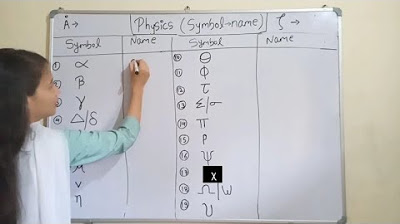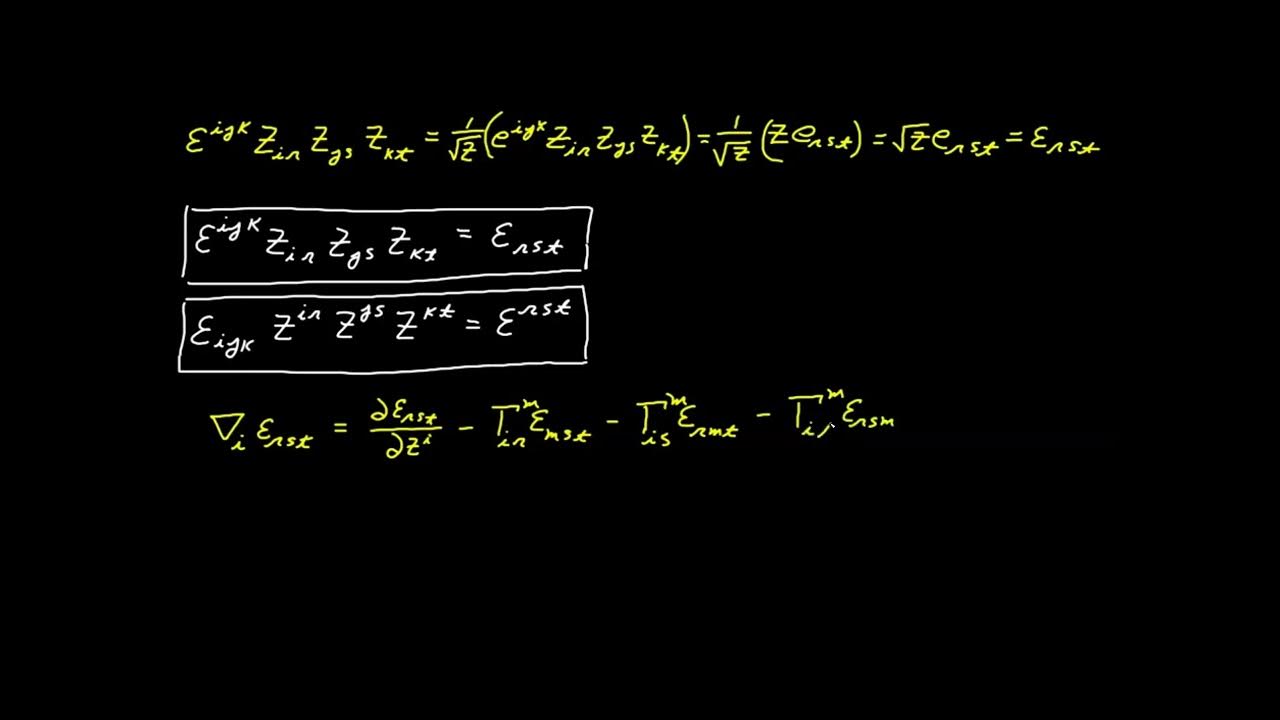What is the meaning of Greek symbols | Delta, del, d | Greek letters in mathematics | Greek symbols
TLDRThis video from 'Physics for Students' explores the various symbols used in mathematics and physics to denote change and difference. It distinguishes between 'delta' (Δ), which signifies a finite, perceptible change, and 'd', representing infinitesimals in calculus. The script also clarifies that the 'curly d' is borrowed from the Cyrillic alphabet and is used for partial differentiation, emphasizing its role in approximating small changes. The video concludes with examples from chemistry and physics, illustrating the practical applications of these symbols in different contexts.
Takeaways
- 😀 The script discusses the use of various symbols in mathematics and physics, particularly focusing on the differences between 'delta', 'del', and 'd'.
- 📚 The Greek letter 'delta' (Δ) is used to denote a finite, perceptible change or difference in various contexts, such as calculus and chemistry.
- 🔍 'Delta' is also used in the Laplace-Beltrami operator in a more advanced context, which is a linear operation in differential geometry.
- 🌡 In chemistry, 'delta' represents changes in enthalpy, often associated with latent heat in reactions.
- 📈 The Latin letter 'd' is used to denote infinitesimals in calculus, signifying an infinitesimally small change, which is not directly observable.
- 📘 The 'curly d' or 'del' is borrowed from the Cyrillic alphabet and is used in partial differential equations to represent very small changes in multivariable functions.
- 📊 'Del' is not interchangeable with 'd'; it specifically denotes an approximation or an estimate in mathematical functions and is used when dealing with non-exact values.
- 📏 'Del' is also used to represent the concept of tolerance levels in limits, indicating the closeness of a variable to a certain value.
- 🌐 The script highlights the importance of understanding the context in which these symbols are used, as they can represent different types of changes or differences.
- 🎓 The video aims to clarify common misconceptions about these symbols and to provide a deeper understanding of their mathematical and scientific significance.
- 🌟 The presenter plans to create a series called 'The Beauty of Mathematics' to explore mathematical concepts found in nature, encouraging viewers to subscribe for updates.
Q & A
What does the Greek letter 'Δ' (delta) typically represent in mathematics and physics?
-In mathematics and physics, the Greek letter 'Δ' (delta) typically represents a finite and perceptible change, often used to denote the difference between an initial and final value.
What is the term 'diaphora' in relation to the Greek alphabet and its meaning?
-The term 'diaphora' is the Greek word for 'difference', which is related to the use of the delta symbol to denote a difference in value or quantity.
Why is the symbol '∇' (nabla) not considered a Greek alphabet?
-The symbol '∇' (nabla) is not a Greek alphabet; it is borrowed from the Cyrillic alphabet and is used in mathematics for partial differentiation and to denote an infinitesimally small change.
How does the script differentiate between the uses of 'Δ', 'd', and '∇' in mathematical expressions?
-The script differentiates by explaining that 'Δ' is used for finite and perceptible changes, 'd' is used for infinitesimally small changes in calculus, and '∇' is used for partial differentiation and represents an infinitesimally small change in multiple dimensions.
What is the Laplace-Beltrami operator in the context of the script?
-The Laplace-Beltrami operator is mentioned as a linear operation that takes functions into functions, defined as the divergence of the gradient. It is used in differential geometry but is outside the main scope of the video.
How is the delta symbol used in chemistry to represent heat?
-In chemistry, the delta symbol is used to represent changes in enthalpy, often denoted as a latent heat or the amount of heat involved in a chemical reaction.
What is the significance of the 'd' symbol in calculus and how is it different from 'Δ'?
-The 'd' symbol in calculus is used to denote infinitesimally small changes and is associated with the concept of a derivative, which represents the rate of change of a function. It differs from 'Δ' in that 'Δ' signifies finite differences that can be observed, while 'd' signifies changes that are infinitesimally small and not directly observable.
Can the symbols 'd' and '∇' be used interchangeably in mathematics?
-No, 'd' and '∇' are not used interchangeably. 'd' is used for derivatives in single-variable calculus, while '∇' is used for partial derivatives in multi-variable calculus and represents a vector of derivatives with respect to multiple variables.
What does the script imply by using the term 'tolerance level' in the context of mathematical limits?
-The term 'tolerance level' in the script refers to the range within which a variable can vary while still being considered 'close' to a certain value. It is used to express the concept of limits in a more tangible way, showing how values approach a certain point within a given range.
How does the script explain the use of 'δ' (delta) in the context of approximation and non-exact functions?
-The script explains that 'δ' is used to denote approximation and non-exact functions, such as when dealing with limits, where it represents the closeness of a variable to a certain value. It is also used in chemistry to denote electron density and in various other contexts where an estimate or approximation is necessary.
Outlines
📚 Introduction to Mathematical and Physical Symbols
The script begins with an introduction to the educational channel 'Physics for Students' and sets the stage for a new video exploring the differences between various mathematical and physical symbols, specifically focusing on 'delta', 'del', and 'd'. The speaker aims to clarify the distinctions and applications of these symbols in the fields of mathematics and physics, starting with the Greek alphabet's 'delta', which commonly denotes a change or difference in calculus and various mathematical contexts.
🔍 Delving into the Concept of 'Delta'
This paragraph delves deeper into the symbol 'delta', explaining its use in mathematics to represent a finite difference or change that is perceptible and observable. The script provides examples of calculating slopes, speeds, and other changes to illustrate the concept of 'delta' as a finite difference. It also touches upon the Laplace-Beltrami operator, a more advanced topic outside the video's main scope, and mentions 'delta' in chemistry as a representation of latent heat or enthalpy changes.
📐 Transition from Finite to Infinitesimal Differences
The script transitions from discussing 'delta' as a finite difference to 'd', which represents an infinitesimal or infinitesimally small change. It uses the analogy of a person walking a distance that can be broken down into infinitely small parts to explain the concept of 'd'. The paragraph also covers the mathematical notation for derivatives, emphasizing that 'd' signifies an imperceptible change that is part of the foundation of calculus.
📘 The Cyrillic 'Curly D' and Partial Differentiation
The script introduces the 'curly d', a symbol borrowed from the Cyrillic alphabet, used in partial differentiation within calculus. It explains that this symbol is not a Greek letter and is used to denote very small changes in functions, particularly when dealing with multiple variables. The paragraph also discusses the historical use of the 'curly d' in partial differential equations and its phonetic usage as 'd'.
📉 Understanding the Symbol 'Del' and Its Applications
This paragraph focuses on the symbol 'del', which is used to represent approximation and non-exact functions. It clarifies that 'del' is not interchangeable with 'd' and provides examples of how 'del' is used in limits and approximations, including its role in expressing tolerance levels and the closeness of variables to a certain value.
🌐 Practical Examples of 'Del' in Physics and Chemistry
The script provides practical examples of how 'del' is used in physics and chemistry, such as calculating the volume of a cylindrical tank and representing electron density in chemical bonds. It emphasizes that 'del' is used for approximations and estimates, which are not exact but provide close values to the actual quantities.
🎓 Summary of Symbolic Differences in Mathematics and Physics
The final paragraph summarizes the key points discussed in the video, distinguishing between 'delta' as a symbol for finite and perceptible change, 'del' for approximation and non-exact functions, and 'd' for infinitesimally small changes in calculus. The speaker also hints at upcoming videos in a series called 'The Beauty of Mathematics', which will explore mathematical concepts found in nature.
Mindmap
Keywords
💡Delta (Δ)
💡Change
💡Difference
💡Diaphora
💡Curly D (∇)
💡Partial Derivative
💡D (d)
💡Laplace-Beltrami Operator
💡Tolerance Level
💡Epsilon (ε)
💡Approximation
Highlights
Introduction to the differences between mathematical signs delta, del, and d, and their significance in mathematics and physics.
Explanation of the Greek alphabet delta (Δ) to denote a change or difference in calculus and mathematics.
The term 'diaphora' from Greek terminology is associated with the concept of difference, not change.
Differentiation between uppercase and lowercase Greek delta and their representation of difference.
Curly d is not a Greek alphabet and is used in calculus and differentiation, unlike delta.
Delta represents a finite difference or perceptible change, observable by the naked eye.
Laplace-Beltrami operator is introduced as a linear operation taking functions into functions, related to the delta symbol.
In chemistry, delta is used to represent latent heat or enthalpy changes.
The Latin letter d signifies infinitesimals in calculus, marking a transition from finite to infinitesimally small differences.
Curly delta (∇) is derived from the Cyrillic alphabet and used for partial differential equations.
Partial differentiation is explained as finding very small changes in function outputs using the curly delta.
Del (δ) is used to denote approximation and non-exact functions, differentiating it from delta and d.
Del is used to represent the closeness or tolerance level in mathematical limits.
The concept of approximation in functions of multiple variables using del is demonstrated.
Examples of cylindrical tanks and angle of elevation problems to illustrate the use of del in approximation.
Del is used in chemistry to represent electron density and polar covalent bonds.
Summary of the uses of delta, del, and d in various mathematical and scientific contexts.
Announcement of upcoming series 'The Beauty of Mathematics' exploring mathematical beauty in nature.
Transcripts
Browse More Related Video

Greek Alphabet Symbols List - College Math, Chemistry, & Physics

physics symbol name|| greek letter in physics|| physic symbol|| class 11&12

Video 51 - Levi Civita Symbols

Physics के 40 महत्वपूर्ण चिन्ह।। Important Symbol of Physics।। बेसिक Physics

Greek Letters in Mathematics

Ch-3 | Basic Maths ( Part 2 ) | Mathematical Tool | Differentiation & Integration | Jee | Neet | 11
5.0 / 5 (0 votes)
Thanks for rating: